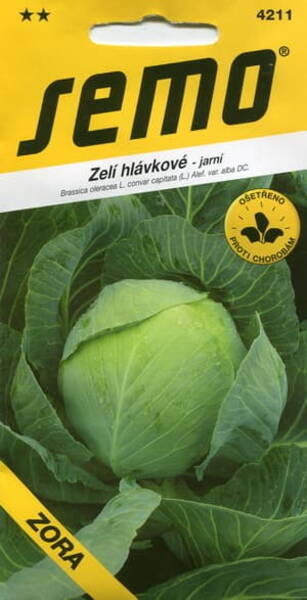A very early-ripening variety for early harvesting for immediate consumption. The head is tightly closed. The variety is resistant to budding.
1.0 g = 250-300 seeds.

* Obtaining your own white cabbage seeds.
Seed production consists of three main steps: growing mother plants, storing them over winter, and growing seedlings. The technology for growing mother plants is virtually identical to that for commercial plants. Unlike food plants, seedlings for cabbage mother plants are planted later to ensure fully formed heads of cabbage that are commercially viable but not overripe. These plants are less susceptible to disease and have better storage properties. They are harvested, roots included, before frost, at the stage of full commercial maturity, and stored in a basement. The heads of cabbage should be intact, free from pest and disease damage, and firm. The size and shape of the heads should correspond to the varietal characteristics. Before storing, the leaves are trimmed from the heads, leaving two or three. To prevent fungal diseases, they are dusted with crushed chalk.
The cabbage head with the stalk is hung upside down or placed on a rack. The mother plants are stored at a temperature of 0 to 1°C (not below -1°C). During the winter, the mother plants are checked. In the last ten days of March to the first days of April, the stalks are removed from the mother plants, any rotten small roots are trimmed, and the heads are placed in a bright room at +7°C to dry out. To prevent the roots from drying out, the heads are placed in a plastic bag with peat or humus.
Important! Cabbage varieties and types cross-breed easily, so only seed plants of one type and variety can be grown in a plot, with the exception of Napa cabbage, which does not cross-breed with other brassicas. Cabbage is a cross-pollinating plant, and bees and bumblebees are the primary pollen carriers. Cabbage reacts negatively to self-pollination, producing a low percentage of pods, and the pods develop with few or no seeds. Pollen remains viable for four days and germinates approximately two hours after landing on the stigma.
Pollen germinates best at temperatures of 15°C to 20°C (it does not germinate at temperatures of 35°C and below 10°C). High humidity also reduces pollen viability. High temperatures during flowering (above 25°C) deform stamens, pistils, and anthers, disrupting normal flower opening and pollination, causing flower shedding, and the formation of empty pods. The most favorable temperature during flowering is 18°C to 19°C. For optimal seed formation, early planting of seed plants is necessary to ensure moderate flowering temperatures.
Important! When growing seedlings, a spatial isolation of at least 600 m must be maintained.
Did you know that... cabbage can be harvested for storage by pulling it out with roots and 2-3 green leaves?
Plants prepared in this way can be hung in the cellar on twine. In this form, the heads of cabbage are preserved until the next harvest.












